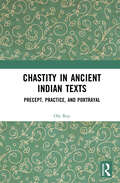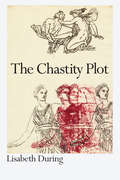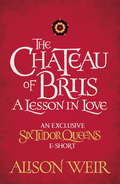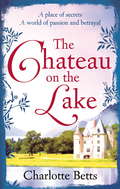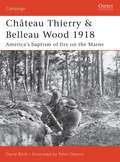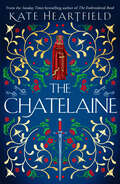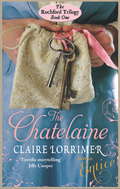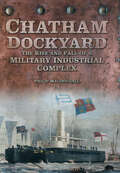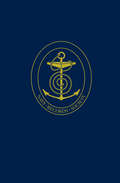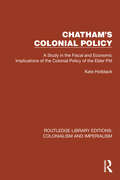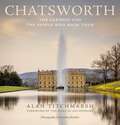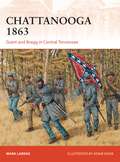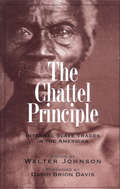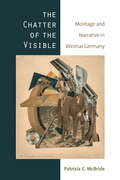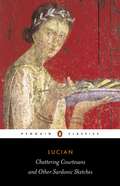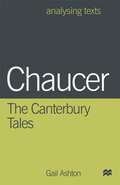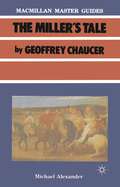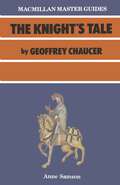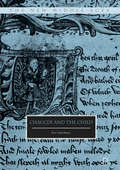- Table View
- List View
Chastity in Ancient Indian Texts: Precept, Practice, and Portrayal
by Oly RoyThis book looks at the representation and practice of chastity in selective ancient Indian texts. It studies how and when the concept originated and in what ways it was intertwined with the social, cultural, and economic notions of Indian society. Drawing on seminal Indian texts such as the MahāPurāṇas, Rāmāyaṇa, Mahābhārata, Sattasaī and the Jātakas, the volume delves into the social and reproductive rights of women through an examination of the norms of chastity, virginity, and Pātivratya, which were construed according to a patriarchal hierarchy of the society and implemented as a means of strengthening patriarchal authority. It also examines the interinfluence of various religious traditions that emerged on the very concept of chastity and the ideologies they later gave rise to. A comprehensive study of sexuality and gender in early India, the book will be indispensable to students, teachers, and researchers of gender studies, literature, women’s studies, women’s rights, feminism, South Asian studies, and social history of Ancient India.
Chastity in Ancient Indian Texts: Precept, Practice, and Portrayal
by Oly RoyThis book looks at the representation and practice of chastity in selective ancient Indian texts. It studies how and when the concept originated and in what ways it was intertwined with the social, cultural, and economic notions of Indian society. Drawing on seminal Indian texts such as the MahāPurāṇas, Rāmāyaṇa, Mahābhārata, Sattasaī and the Jātakas, the volume delves into the social and reproductive rights of women through an examination of the norms of chastity, virginity, and Pātivratya, which were construed according to a patriarchal hierarchy of the society and implemented as a means of strengthening patriarchal authority. It also examines the interinfluence of various religious traditions that emerged on the very concept of chastity and the ideologies they later gave rise to. A comprehensive study of sexuality and gender in early India, the book will be indispensable to students, teachers, and researchers of gender studies, literature, women’s studies, women’s rights, feminism, South Asian studies, and social history of Ancient India.
The Chastity Plot
by Lisabeth DuringIn The Chastity Plot, Lisabeth During tells the story of the rise, fall, and transformation of the ideal of chastity. From its role in the practice of asceticism to its associations with sovereignty, violence, and the purity of nature, it has been loved, honored, and despised. Obsession with chastity has played a powerful and disturbing role in our moral imagination. It has enforced patriarchy’s double standards, complicated sexual relations, and imbedded in Western culture a myth of gender that has been long contested by feminists. Still not yet fully understood, the chastity plot remains with us, and the metaphysics of purity continue to haunt literature, religion, and philosophy. Idealized and unattainable, sexual renunciation has shaped social institutions, political power, ethical norms, and clerical abuses. It has led to destruction and passion, to seductive fantasies that inspired saints and provoked libertines. As During shows, it should not be underestimated. Examining literature, religion, psychoanalysis, and cultural history from antiquity through the middle ages and into modernity, During provides a sweeping history of chastity and insight into its subversive potential. Instead of simply asking what chastity is, During considers what chastity can do, why we should care, and how it might provide a productive disruption, generating new ways of thinking about sex, integrity, and freedom.
The Chastity Plot
by Lisabeth DuringIn The Chastity Plot, Lisabeth During tells the story of the rise, fall, and transformation of the ideal of chastity. From its role in the practice of asceticism to its associations with sovereignty, violence, and the purity of nature, it has been loved, honored, and despised. Obsession with chastity has played a powerful and disturbing role in our moral imagination. It has enforced patriarchy’s double standards, complicated sexual relations, and imbedded in Western culture a myth of gender that has been long contested by feminists. Still not yet fully understood, the chastity plot remains with us, and the metaphysics of purity continue to haunt literature, religion, and philosophy. Idealized and unattainable, sexual renunciation has shaped social institutions, political power, ethical norms, and clerical abuses. It has led to destruction and passion, to seductive fantasies that inspired saints and provoked libertines. As During shows, it should not be underestimated. Examining literature, religion, psychoanalysis, and cultural history from antiquity through the middle ages and into modernity, During provides a sweeping history of chastity and insight into its subversive potential. Instead of simply asking what chastity is, During considers what chastity can do, why we should care, and how it might provide a productive disruption, generating new ways of thinking about sex, integrity, and freedom.
The Chateau of Briis: A Lesson in Love
by Alison WeirThe Chateau of Briis: A Lesson in Love by historian Alison Weir is an e-short and companion piece to the Sunday Times bestseller Anne Boleyn: A King's Obsession, the second novel in the spellbinding series about Henry VIII's queens.'May I have the pleasure of your hand in the dance, mademoiselle?'1515 - Dressed in wine-coloured satin, with her dark hair worn loose, a young Anne Boleyn attends a great ball at the French court. The palace is exquisitely decorated for the occasion, and the hall is full with lords and ladies - the dancing has begun. Anne adores watching the game of courtly love play out before her eyes, though she is not expecting to be thrown into it herself. But moments later, a charming young man named Philippe du Moulin approaches to ask for her hand in the dance. And before she can resist, so begins Anne's first lesson in love. Includes the first chapters of Anne Boleyn: A King's Obsession and Jane Seymour: The Haunted Queen. SIX TUDOR QUEENS. SIX NOVELS. SIX YEARS.
The Chateau on the Lake (War At Home Ser.)
by Charlotte BettsA compelling tale of romance and betrayal set during the danger of the French Revolution, perfect for readers of Dinah Jefferies, Lucinda Riley and Jenny Ashcroft. 'Romantic, engaging and hugely satisfying' Katie Fforde on The Apothecary's Daughter1792. As a teacher at her parents' Academy for Young Ladies in the heart of London, Madeleine Moreau has lived her life sheltered from the outside world. But on the night of a dazzling Masquerade, tragedy strikes and she is left alone in the world. Desperate to find the family she never knew, Madeleine impulsively travels to France in search of them. But with war around the corner, and fearing for Madeleine's safety, the enigmatic Comte Etienne d'Aubery offers her protection at his home, Chateau Mirabelle.Chateau Mirabelle enchants Madeleine with its startling beauty, but it is a place of dark and haunting secrets. As the Revolution gathers momentum and the passions of the populace are enflamed, Madeleine must take control of her own destiny and unravel events of the past in order to secure a chance of future happiness. Praise for Charlotte Betts'Betts' description is second to none . . . you inhale all the sights, sounds and smells of the setting and engage with every one of the characters. I stayed awake until 3am to finish it. A superb book' The Sun'Full of passion and drama . . . I was captivated by this moving, heart-warming and beautifully woven story - gripping, atmospheric, eloquently told and full of rich detail' Kate Furnivall, bestselling author of The Russian Concubine'You will never be disappointed with a Charlotte Betts book!' Amazon reviewer'Well-written and thought-provoking' Goodreads reviewer'A fantastic story loaded with history' Amazon reviewer
Château Thierry & Belleau Wood 1918: America’s baptism of fire on the Marne (Campaign #177)
by David BonkIn May and June 1918 the newly arrived American Expeditionary Force fought two actions that helped defeat the last German offensive of World War I. At Château Thierry a combined French and American force stopped the Germans from crossing the Marne River. Building on this success the US 2nd Division stopped the German advance on Paris and were given the task of recapturing Belleau Wood. First-hand accounts, photographs, and detailed maps dramatically bring to life these key battles, America's baptism of fire in World War I.
Château Thierry & Belleau Wood 1918: America’s baptism of fire on the Marne (Campaign #177)
by Peter Dennis David BonkIn May and June 1918 the newly arrived American Expeditionary Force fought two actions that helped defeat the last German offensive of World War I. At Château Thierry a combined French and American force stopped the Germans from crossing the Marne River. Building on this success the US 2nd Division stopped the German advance on Paris and were given the task of recapturing Belleau Wood. First-hand accounts, photographs, and detailed maps dramatically bring to life these key battles, America's baptism of fire in World War I.
The Chatelaine
by Kate HeartfieldWinner of the Aurora Award for Best Novel Hell is empty and all the devils are here. The Chatelaine has come.
The Chatelaine: Number 1 in series (Rochford Trilogy #1)
by Claire LorrimerOnly Willoughby Tetford, the American self-made millionaire, was shrewd enough to have any misgivings when his beautiful daughter, Willow, married the handsome English aristocrat. Willow herself, seventeen, innocent and deeply in love with her new husband, Rowell Rochford, had complete trust and confidence in the future as she arrived at Rochford Manor in England. And when Rowell's matriarchal French grandmother handed her the keys of the house and told she was the new Chatelaine, Willow believed she held the keys not only to the multitude of rooms of which she was now the mistress but also to love and happiness. On her arrival, she is greeted warmly by her four brothers-in-law: Tony, quiet and studious; Pelham, teasing and flirtatious, the spoilt Francis and the sensitive Rupert. But she has no inkling of the obsession which grips old Lady Rochford because of events in the past to which she, Willow is ignorant. Nor does she realise the terrible repercussions the obsession will have on her own life.
Chatham Dockyard: The Rise and Fall of a Military Industrial Complex
by Philip MacDougallFounded in 1570, Chatham Dockyard quickly became one of the most important naval yards for the repair and building of warships, maintaining a pre-eminent position for the next 400 years. Located on the River Medway, in all, the yard was responsible for the construction of over 500 warships, these ranging from simple naval pinnaces through to first-rates that fought at Trafalgar, and concluding with the hunter-killer submarines of the nuclear age. In this detailed new history of the yard from experienced local and maritime author Philip MacDougall, particular attention is given to the final two hundred years of the yard’s history, the artisans and labourers who worked there and the changing methods used in the construction of some of the finest warships to enter naval service. Coinciding with the dockyard’s seeking status as a World Heritage site, this fascinating history places Chatham firmly in its overall historical context.
Chatham Dockyard, 1815-1865: The Industrial Transformation
by Philip MacdougallBy the end of the Napoleonic Wars, the seven home dockyards of the British Royal Navy employed a workforce of nearly 16,000 men and some women. On account of their size, dockyards add much to our understanding of developing social processes as they pioneered systems of recruitment, training and supervision of large-scale workforces. From 1815-1865 the make-up of those workforces changed with metal working skills replacing wood working skills as dockyards fully harnessed the use of steam and made the conversion from constructing ships of timber to those of iron. The impact on industrial relations and on the environment of the yards was enormous. Concentrating on the yard at Chatham, the book examines how the day-to-day running of a major centre of industrial production changed during this period of transition. The Admiralty decision to build at Chatham the Achilles, the first iron ship to be constructed in a royal dockyard, placed that yard at the forefront of technological change. Had Chatham failed to complete the task satisfactorily, the future of the royal dockyards might have been very different.
Chatham Dockyard, 1815-1865: The Industrial Transformation
by Philip MacDougallBy the end of the Napoleonic Wars, the seven home dockyards of the British Royal Navy employed a workforce of nearly 16,000 men and some women. On account of their size, dockyards add much to our understanding of developing social processes as they pioneered systems of recruitment, training and supervision of large-scale workforces. From 1815-1865 the make-up of those workforces changed with metal working skills replacing wood working skills as dockyards fully harnessed the use of steam and made the conversion from constructing ships of timber to those of iron. The impact on industrial relations and on the environment of the yards was enormous. Concentrating on the yard at Chatham, the book examines how the day-to-day running of a major centre of industrial production changed during this period of transition. The Admiralty decision to build at Chatham the Achilles, the first iron ship to be constructed in a royal dockyard, placed that yard at the forefront of technological change. Had Chatham failed to complete the task satisfactorily, the future of the royal dockyards might have been very different.
Chatham's Colonial Policy: A Study in the Fiscal and Economic Implications of the Colonial Policy of the Elder Pitt (Routledge Library Editions: Colonialism and Imperialism #13)
by Kate HotblackChatham's Colonial Policy (1917) examines Britain’s colonial plans and ambition in the mid-eighteenth century, under the leadership of the Earl of Chatham – William Pitt the Elder. It analyses his policies for British control around the world, most notably in the West Indies, North America, Africa and India, and how these policies brought Britain into conflict with Europe’s two main colonial powers, Spain and France.
Chatham's Colonial Policy: A Study in the Fiscal and Economic Implications of the Colonial Policy of the Elder Pitt (Routledge Library Editions: Colonialism and Imperialism #13)
by Kate HotblackChatham's Colonial Policy (1917) examines Britain’s colonial plans and ambition in the mid-eighteenth century, under the leadership of the Earl of Chatham – William Pitt the Elder. It analyses his policies for British control around the world, most notably in the West Indies, North America, Africa and India, and how these policies brought Britain into conflict with Europe’s two main colonial powers, Spain and France.
Chatsworth: The gardens and the people who made them
by Alan TitchmarshDiscover Jane Austen's real-life inspiration for Darcy's Pemberley.Follow Alan into Chatsworth's irresistible world of visionaries, pioneers, heroes, villains and English eccentrics, and celebrate the men and women who have shaped the history of the estate over five centuries. With his passionate knowledge of both the house and gardens, as well as his long-established relationship with the Cavendish family, Alan is the perfect guide with whom to explore the Palace of the Peaks.Featuring stunning, specially commissioned photography of the gardens and parkland, alongside long-forgotten images and memorabilia newly unearthed in the estate archives, this vivid companion, crowded with character and colour, is a book to treasure and revisit over and over again.
Chattanooga 1863: Grant and Bragg in Central Tennessee (Campaign)
by Adam Hook Mark LardasFollowing the disastrous defeat at Chickamauga, Union forces were in disarray and the tactically vital Chattanooga was under siege and on the brink of falling. Secretary of War William Stanton ordered Ulysses Grant to send the Army of Tennessee to reinforce Chattanooga. Grant had already reacted.The situation was dire. It required outstanding leadership to rescue the situation. President Abraham Lincoln decided Grant was the man for the occasion. In early October, Grant was promoted to command of the Military District of Mississippi and told to clean up the mess created by Chickamauga. With those orders a new campaign began: the Chattanooga Campaign. This book tracks how over the next three months Grant would orchestrate the movements of three Union Armies – The Army of the Cumberland, The Army of the Tennessee, and two Corps from the Army of the Potomac. He would lead them into a series of battles that saw them break the siege of Chattanooga before in three battles in three days the Union forces broke the Confederate army entrenched in the heights overlooking Chattanooga.
Chattanooga 1863: Grant and Bragg in Central Tennessee (Campaign #295)
by Mark Lardas Mr Adam HookFollowing the disastrous defeat at Chickamauga, Union forces were in disarray and the tactically vital Chattanooga was under siege and on the brink of falling. Secretary of War William Stanton ordered Ulysses Grant to send the Army of Tennessee to reinforce Chattanooga. Grant had already reacted.The situation was dire. It required outstanding leadership to rescue the situation. President Abraham Lincoln decided Grant was the man for the occasion. In early October, Grant was promoted to command of the Military District of Mississippi and told to clean up the mess created by Chickamauga. With those orders a new campaign began: the Chattanooga Campaign. This book tracks how over the next three months Grant would orchestrate the movements of three Union Armies – The Army of the Cumberland, The Army of the Tennessee, and two Corps from the Army of the Potomac. He would lead them into a series of battles that saw them break the siege of Chattanooga before in three battles in three days the Union forces broke the Confederate army entrenched in the heights overlooking Chattanooga.
The Chattel Principle: Internal Slave Trades in the Americas (The David Brion Davis Series)
by Walter JohnsonThis wide-ranging book presents the first comprehensive and comparative account of the slave trade within the nations and colonial systems of the Americas. While most scholarly attention to slavery in the Americas has concentrated on international transatlantic trade, the essays in this volume focus on the slave trades within Brazil, the West Indies, and the Southern states of the United States after the closing of the Atlantic slave trade.The contributors cast new light upon questions that have framed the study of slavery in the Americas for decades. The book investigates such topics as the illegal slave trade in Cuba, the Creole slave revolt in the U.S., and the debate between pro- and antislavery factions over the interstate slave trade in the South. Together, the authors offer fresh and provocative insights into the interrelations of capitalism, sovereignty, and slavery.
The Chatter of the Visible: Montage and Narrative in Weimar Germany
by Patrizia C McBrideThe Chatter of the Visible examines the paradoxical narrative features of the photomontage aesthetics of artists associated with Dada, Constructivism, and the New Objectivity. While montage strategies have commonly been associated with the purposeful interruption of and challenge to narrative consistency and continuity, McBride offers an historicized reappraisal of 1920s and 1930s German photomontage work to show that its peculiar mimicry was less a rejection of narrative and more an extension or permutation of it—a means for thinking in narrative textures exceeding constraints imposed by “flat” print media (especially the novel and other literary genres). McBride’s contribution to the conversation around Weimar-era montage is in her situation of the form of the work as a discursive practice in its own right, which affords humans a new way to negotiate temporality, as a particular mode of thinking that productively relates the particular to the universal, or as a culturally specific form of cognition.
Chattering Courtesans and Other Sardonic Sketches
by Lucian Keith SidwellDescribed by a later Greek historian as "a man seriously committed to raising a laugh", Lucian exulted in the exposure of absurdity and the puncturing of pretension, and was capable of finding a comic angle on almost any subject. In this selection we see him conversing with his literary enemies, railing against hypocrisy and the vanity of human wealth and power, and taking a wry look at the power of lust and the unsatisfactory nature of deviant sexual practices.
Chaucer: The Canterbury Tales (Analysing Texts)
by Gail AshtonDetailed textual analysis of the tales by the Miller, Nun's Priest, the Wife of Bath and the Pardoner, as well as the General Prologue invites you to sharpen your critical faculties, extend your knowledge and engage with the text itself in order to fully appreciate the work of this fascinating, complex and surprisingly modern writer. Whether you consider yourself an expert or a student, this study has something for you as it demonstrates the various approaches which can be used to learn about style, structure, multiple voices and the key themes of Chaucer's work. It offers a careful support and thoughtful framework upon which to base your own analysis and challenging you to form your own ideas and opinions.
Chaucer: Large Student Annotation Edition: Formatted With Wide Spacing And Margins And An Extra Page For Notes After Each Page Of Verse (pdf) (Palgrave Master Guides #Vol. 2)
by Geoffrey Chaucer Michael AlexanderAuthor Michael Alexander: Michael Alexander is Emeritus Professor of English Literature, University of St Andrews, UK. He is a poet and translator and has international experience of teaching English literature, both medieval and modern. Author Michael Alexander: Michael Alexander is Emeritus Professor of English Literature, University of St Andrews, UK. He is a poet and translator and has international experience of teaching English literature, both medieval and modern.
Chaucer: (pdf) (Bloomsbury Master Guides)
by Anne SamsonThis ebook is now available from Bloomsbury Academic. Bloomsbury Academic publish acclaimed resources for undergraduate and postgraduate courses across a broad range of subjects including Art & Visual Culture, Biblical Studies, Business & Management, Drama & Performance Studies, Economics, Education, Film & Media, History, Linguistics, Literary Studies, Philosophy, Politics & International Relations, Religious Studies, Social Work & Social Welfare, Study Skills and Theology. Visit bloomsbury.com for more information.
Chaucer and the Child (The New Middle Ages)
by Eve SalisburyThis book addresses portrayals of children in a wide array of Chaucerian works. Situated within a larger discourse on childhood, Ages of Man theories, and debates about the status of the child in the late fourteenth century, Chaucer’s literary children—from infant to adolescent—offer a means by which to hear the voices of youth not prominently treated in social history. The readings in this study urge our attention to literary children, encouraging us to think more thoroughly about the Chaucerian collection from their perspectives. Eve Salisbury argues that the child is neither missing in the late Middle Ages nor in Chaucer’s work, but is,rather, fundamental to the institutions of the time and central to the poet’s concerns.
